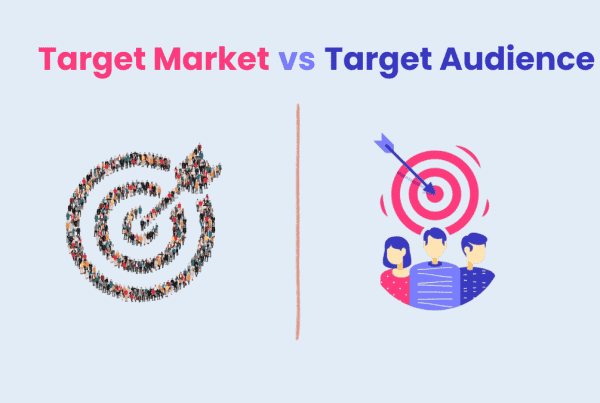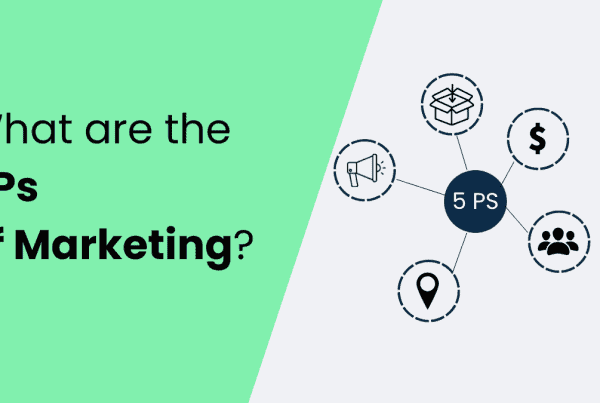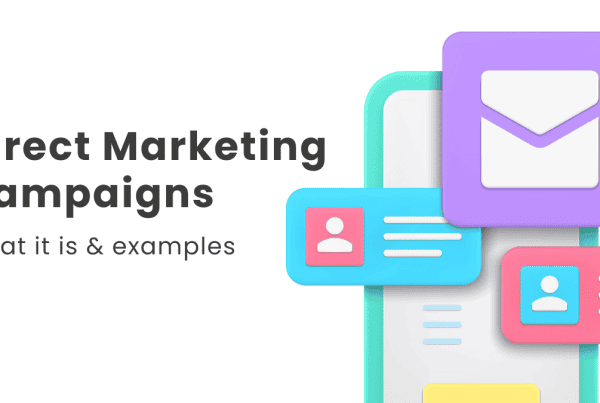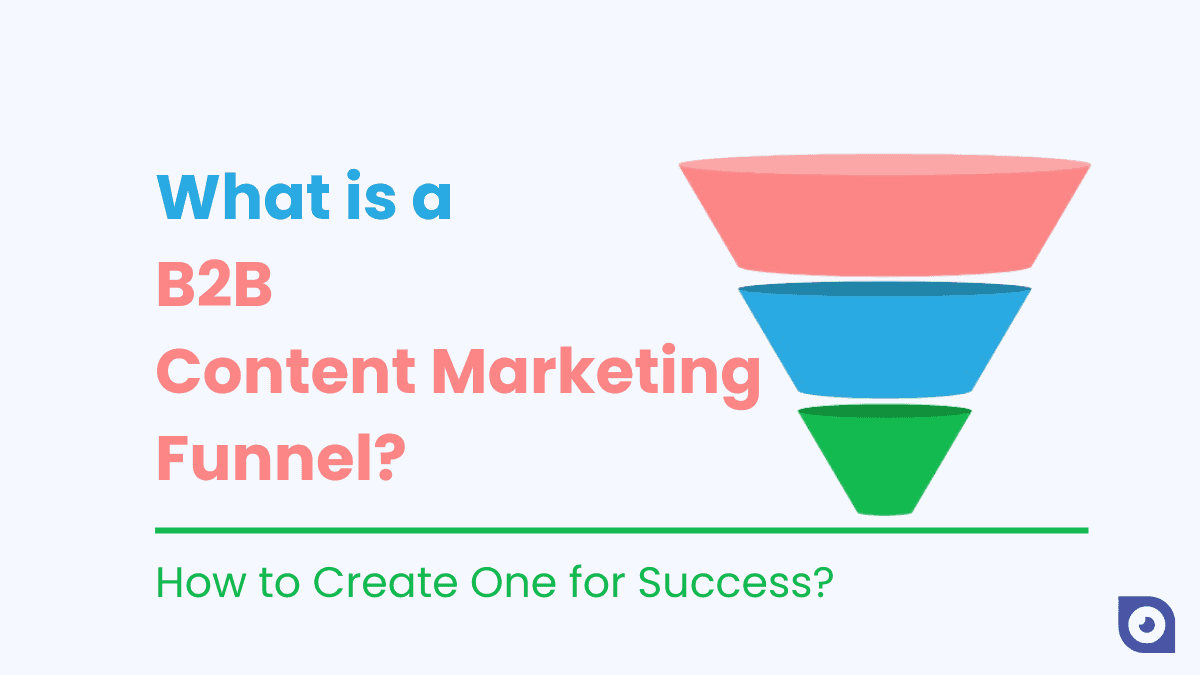
It does not matter whether your business is B2C, B2B, or B2G (business to government); at the end of the day, your business needs customers. If you are running a B2B business, you need individual buyers, and your B2B needs other businesses as its customers.
Are you running a B2B business and struggling to answer buyer questions, address their doubts, and overcome objections in a single marketing campaign? You’re not alone. Many marketers find it challenging to attract the right audience, keep them engaged, and ultimately convert them into loyal customers.
But what if there was a way to streamline your efforts and achieve better results? A solution that not only brings in relevant traffic but also helps guide businesses seamlessly toward making a deal (purchase).
That’s the power of a B2B Content Marketing Funnel. In research on B2B business, Content marketing insight found that nearly half of B2B organizations plan to increase their content budgets next year, with only 6% planning to cut back-highlighting content marketing’s strong ROI potential in the B2B sector. Let’s explore the B2B Content Marketing Funnel and learn how to create one effectively for a B2B business.
What is a B2B content marketing funnel?
A B2B content marketing funnel is a step-by-step framework that helps businesses guide potential customers through their buying journey from discovering your brand to becoming loyal, long-term customers.
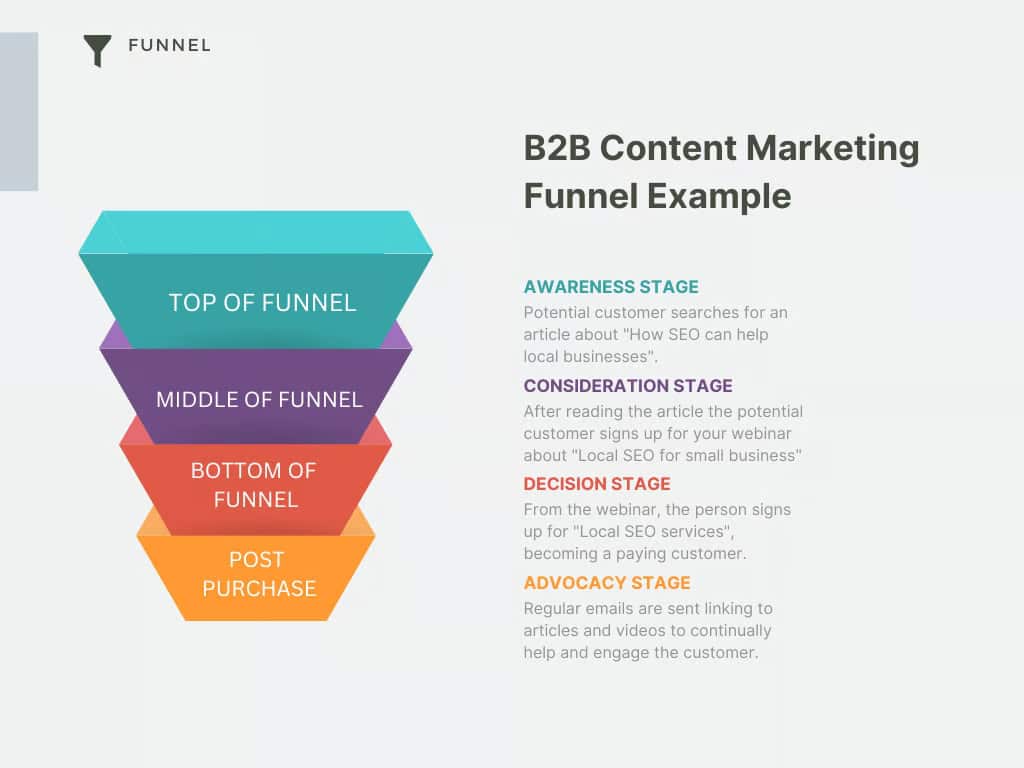
It is like a roadmap that starts with building awareness, nurturing interest, addressing doubts, and finally, encouraging confident purchasing decisions.
For example, a company selling project management software might start with blog posts about improving team productivity (awareness), followed by case studies showcasing successful implementations (consideration), and end with personalized demos or free trials (decision).
Unlike quick consumer sales, the B2B funnel takes longer and requires personalized strategies for each stage. By segmenting your audience based on their position in the funnel, you can create targeted content to keep them engaged, improve customer satisfaction, and even encourage repeat business or advocacy.
Advantages of implementing a B2B Content marketing funnel
Here are the key benefits of implementing a B2B content marketing funnel:
- Matches the Customer Journey: A B2B funnel aligns marketing efforts with each customer journey stage. It helps create content that addresses prospects’ needs and guides them smoothly toward making a decision.
- Nurtures Leads for Stronger Relationships: It keeps potential customers engaged by providing helpful content at the right time. This builds trust, strengthens relationships, and increases customer loyalty, which can boost long-term profits.
- Attracts Free Traffic: High-quality, useful content brings in visitors from search engines and social media. This reduces the need for paid ads, saves money, and attracts more qualified leads. According to the Profile tree, social media is the top choice for sharing B2B content, and it is used by 93% of B2B marketers.
- Boosts Brand Awareness and Credibility: Sharing valuable content positions your business as an expert in your industry. When customers trust your solutions, they see your brand as reliable and are more likely to remember it.
- Improves Targeting: By understanding where prospects are in their buying journey, you can send them personalized messages that increase the chances of success and reduce wasted effort.
- Drives Better Conversions: Content tailored to address specific customer concerns helps them feel confident in their decisions, leading to higher conversion rates.
- Measures Success for Improvement: A clear funnel allows you to track results at each stage. By analyzing performance, you can find problem areas, adjust strategies, and continuously improve.
- Aligns Sales and Marketing Teams: The funnel helps both teams work together by understanding the customer journey. This ensures better communication, smoother processes, and stronger results.
B2C vs B2B content marketing funnels
Here’s a concise comparison table for B2C vs B2B Content Marketing Funnels:
| Aspect | B2C content marketing funnel | B2B content marketing funnel |
| Audience | Individual customers | Business decision-makers |
| Goal | Drive quick purchases | Build long-term relationships and close deals |
| Focus | Emotions, entertainment, and benefits | Logic, ROI, and data-driven solutions |
| Content Style | Short, engaging, and visually appealing | In-depth, detailed, and professional |
| Common Platforms | Social media, websites, and email campaigns | LinkedIn, webinars, whitepapers, and industry forums |
| Buying Cycle | Short and impulsive | Long and research-driven |
| Key Metrics | Clicks, likes, conversions | Leads, client acquisition, and ROI |
| Content Types | Ads, videos, blogs, and product reviews | Case studies, whitepapers, and thought leadership blogs |
| Decision Influencers | Personal preferences and peer opinions | Team decisions and budget considerations |
Why is a B2B content marketing funnel important?
A B2B content marketing funnel helps businesses understand how potential customers move from learning about their products or services to making a purchase and beyond. It’s a structured approach to guiding prospects and keeping customers engaged, ensuring long-term growth and success.
It is not just about creating content; it’s about using that content strategically to guide potential customers, keep current ones engaged, and grow your business. It helps you focus on what matters, deliver the right messages at the right time, and achieve better results.
Stages of the B2B content marketing funnel
It is divided into different stages, each focusing on a specific phase of the buyer’s journey. Let’s break it down in simple terms:
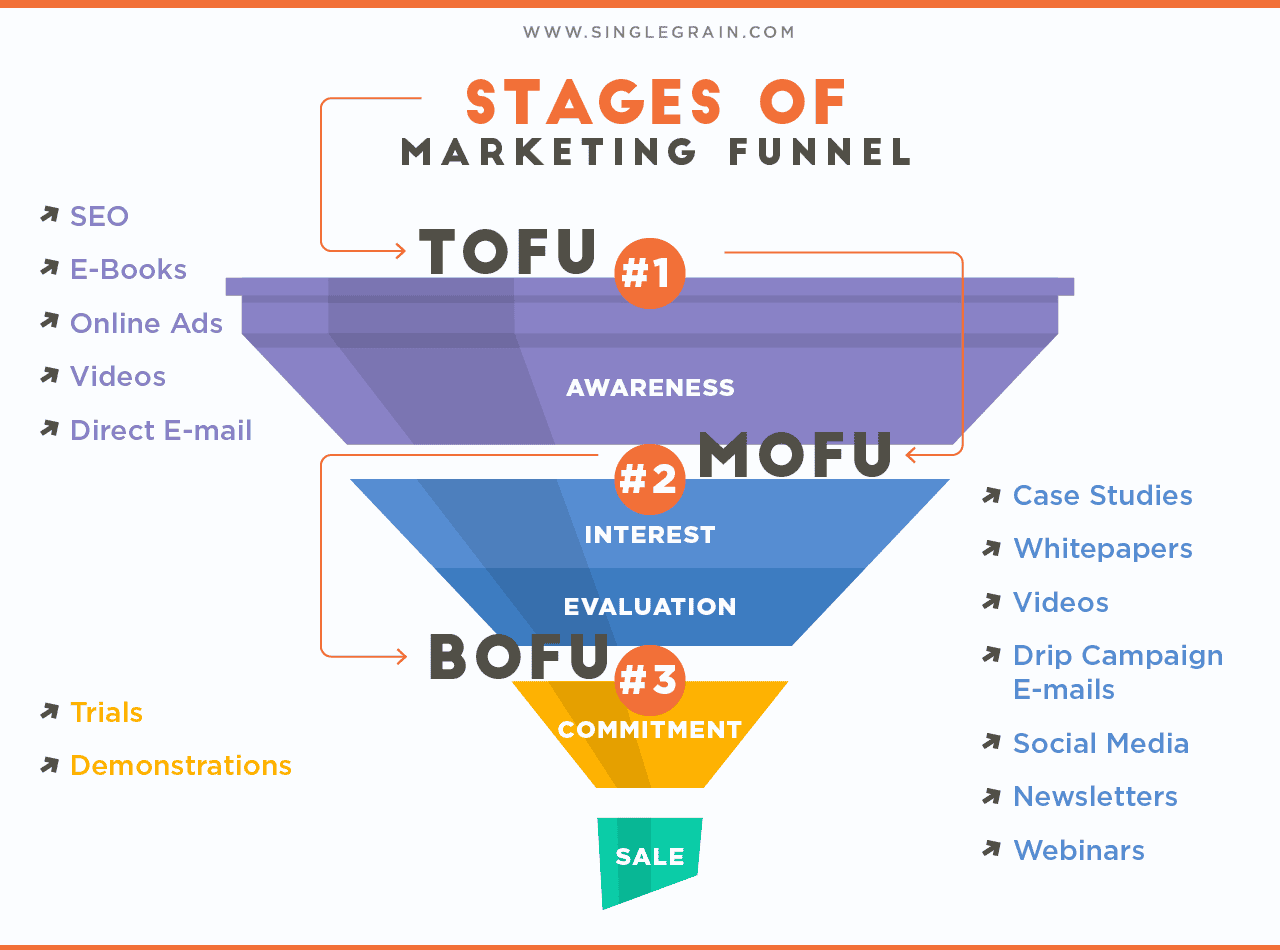
Awareness stage (top of the funnel – TOFU)
This is the first step, where potential customers realize they have a problem or need but don’t know the solution yet. They’re looking for information to understand their problem better.
Businesses should focus on creating content that grabs attention and educates. The goal is to make people aware of your brand while addressing their challenges.
Interest & evaluation stage (middle of the funnel – MOFU)
In this stage, potential customers are actively searching for solutions and evaluating different options. They’re comparing products or services to see what fits their needs.
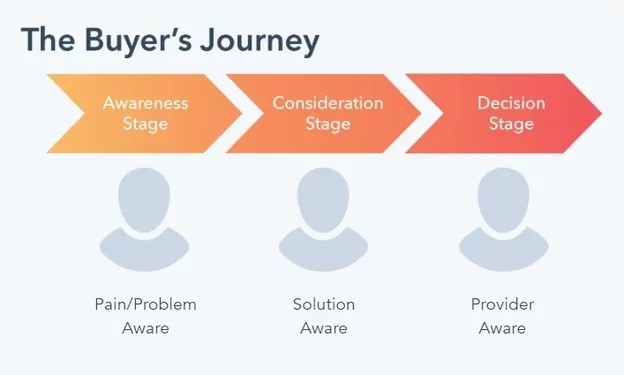
At this point, you need to build trust by showing why your solution is the best. Provide detailed and valuable information about your product or service.
Purchase stage (bottom of the funnel – BOFU)
Now, customers are ready to make a decision. They’ve narrowed down their options and are looking for that final piece of assurance to move forward.
Here’s where you convince them to choose you. Provide offers and clear information to make it easy for them to buy.
Retention & loyalty stage (beyond the funnel)
After the customer has purchased your product or service, the journey doesn’t end. Happy customers are more likely to come back and recommend your business to others.
Focus on keeping your customers satisfied and loyal. Provide value even after the sale to ensure they continue to trust your brand.
How to create a B2B content marketing funnel?
According to WebFX, content marketing is said to generate more leads than traditional marketing methods, 91% of B2B companies. So, building a funnel and creating content for each stage is vital for B2B businesses. Building a B2B content marketing funnel might seem complex, but when broken down into steps, it’s quite straightforward.
Here’s how you can create a content funnel that attracts, engages, and converts your target audience:
Step 1. Understand your audience deeply
Before creating any content, you need to know your audience inside out. Who are they? What challenges do they face? What are their goals?
Start by talking to your sales team-they often know the common problems and questions your customers have. Go further by:
- Checking what your audience shares on social media.
- Conducting surveys, polls, or interviews to learn directly from them.
- Analyzing website analytics to understand which pages, topics, or products generate the most interest.
- Reviewing customer feedback, reviews, and support tickets to uncover pain points or frequently asked questions.
- Monitoring competitors’ content to see what resonates with a similar audience and identify gaps in your strategy.
- Leveraging tools like Google Trends, keyword research, or audience analysis platforms to gather data-driven insights.
Once you’ve gathered enough information, build buyer personas-fictional profiles of your ideal customers. These personas help you decide on the tone, style, and topics of your content. For example, knowing their job role or education level helps you create content that speaks directly to them. You can achieve that by adding one extra text box, for job/qualification, in account creation form as well.
Imagine XYZ Company offers cloud-based project management software. Their target audience is mid-sized businesses (ABC audience), especially managers who find it hard to delegate tasks and keep track of projects.
The marketing team at XYZ discovers that their audience often searches for things like “best project management tools,” “how to track team progress online,” and “top software for task delegation.”
After analyzing this data and talking to their customers, XYZ realizes their audience values simplicity, real-time updates, and affordability. To serve them better:
- They create a profile of their ideal customer called “Project Manager Alex,” a 35-year-old manager with limited time and basic tech skills.
- Knowing Alex’s challenges, XYZ writes blogs like “5 Ways to Simplify Task Delegation” and creates eBooks like “Maximizing Productivity with Cloud-Based Solutions.”
- They also add a “Job Role” field to their sign-up form to learn more about their users and make their content even more relevant.
By understanding their audience and using this data, XYZ ensures their content connects with the right people and effectively leads them through the marketing funnel.
Step 2. Plan content for each funnel stage
Your audience goes through different stages before making a purchase. To guide them, create specific content for each stage:
- Awareness Stage (Top of the Funnel – TOFU): Create content like blog posts, videos, or infographics that answer their basic questions and build trust. Example: “10 Ways to Solve [Customer Problem].”
- Consideration Stage (Middle of the Funnel – MOFU): Offer deeper insights through webinars, case studies, or free guides.For example: “How Our Tool Solves Your [Specific Challenge].”
- Decision Stage (Bottom of the Funnel – BOFU): Provide content that convinces them to act, like product demos, success stories, or free trials. Example: “Customer Testimonials That Show Results.”
Remember, each stage is important! Don’t just focus on the decision stage; otherwise, you miss the chance to engage potential leads early. Additionally, keep in mind that the most popular content formats for B2B marketers are short articles (94%), videos (84%), and case studies (78%).
Step 3. Set clear goals for your funnel
Before creating content, decide what you want to achieve. Your goals should be clear and measurable. Use the SMART goal framework:
- S: Specific (e.g., Get 300 email signups this month).
- M: Measurable (Track leads through signups).
- A: Achievable (Do you have the resources to achieve it?).
- R: Relevant (It should align with your overall business goals).
- T: Time-bound (Set a deadline).
For example, your goal might be to convert 10% of visitors from a landing page into trial users by the end of the month.
Step 4. Track and analyze content performance
To know if your funnel is working, measure how your content performs at every stage. Look at these key metrics:
- Awareness Stage: Traffic, click-through rates, and time spent on pages.
- Consideration Stage: Downloads, signups, or webinar attendance.
- Decision Stage: Conversion rates, sales revenue, and customer acquisition cost.
- Advocacy Stage (Post-Purchase): Customer satisfaction, repeat purchases, and referrals.
Use tools like Google Analytics to track website performance or tools for surveys and customer feedback to gauge satisfaction.
Step 5. Keep improving your funnel
Your funnel isn’t a “set-it-and-forget-it” system. Regularly review your funnel to find areas where leads drop off or lose interest. Ask yourself:
- Are there pages where visitors stop interacting?
- Does your content answer all the right questions?
- Are your calls-to-action (CTAs) clear enough?
Once you identify issues, tweak your content or approach. For example, if your landing page isn’t converting well, try adding customer testimonials or improving the design.
How do you create content for each stage of the B2B content marketing funnel?
Once you’ve understood how to set up a B2B content marketing funnel, the next step is to figure out the right type of content for each stage of the funnel. Each stage represents a different point in your customer’s journey, and your content should guide them through it. Here’s how:
1. Awareness stage (Top of Funnel – TOFU)
Most people begin their search for solutions on Google or other search engines, so SEO-friendly content works best here. The focus should be on addressing user intent, answering their questions, and providing valuable information to help them understand their problem better.
At this stage, buyers are not ready to make a purchase. They’re looking for insights and knowledge, not sales pitches. Your goal is to build trust and position yourself as a helpful expert.
Best types of content for the awareness stage:
- Explainer content: Breaks down complex topics into simple terms.
- Beginner guides: Offers step-by-step knowledge for newcomers.
- Introductory content: Gives an overview of the problem or industry trends.
Best formats for the awareness stage:
- Blog posts
- Social media updates
- Videos
- Infographics
- Podcasts
Example: Blog Post – “Beginner’s Guide to Understanding Brand Erosion in Luxury eCommerce.”
2. Consideration stage (middle of funnel – MOFU)
At this stage, your content should show that you are knowledgeable, experienced, and capable of meeting their needs. Using thought leadership-like case studies, reports, or comparison guides can build confidence in your expertise.
Address concerns and questions about your offering while highlighting its benefits compared to alternatives.
Best types of content for the consideration stage:
- How-to content: Shows practical ways to solve their problem.
- Case studies: Real-world examples of your successes.
- Product insights: Demonstrates how your solution works.
Best formats for the considerations stage:
- Case studies
- Webinars
- White papers
- Reports
Example: Webinar – “How The Luxury Agency Uses Brand Storytelling to Prevent Brand Erosion.”
3. Decision stage (bottom of funnel – BOFU)
Use content that emphasizes why your solution is the best option. Add social proof, like customer testimonials and success stories, to build trust. Offering free trials, demos, or discounts can also motivate the buyer to act quickly.
Even small obstacles, like unclear information or a complicated checkout process, can drive potential customers away. Make sure everything is easy to understand and use.
Best types of content for the decision stage:
- Customer stories: Share how others have benefited from your product.
- FAQs: Answer questions about your product/service clearly.
- Promotional offers: Discounts or free trials to encourage immediate action.
Best formats for the decision stage:
- Demos
- Free trials
- Testimonials
- Consultations
- Discount offers
Example: Discount Offer – “Sign Up Within 7 Days to Get 10% Off Your Personalized Brand Guide.”
4. Advocacy stage (post-purchase)
Most marketers stop at the decision stage, but building loyalty after a purchase is critical for long-term success.
At this stage, prioritize customer support and personalized content. Keep your customers informed about updates, offer exclusive benefits, and ensure their questions are answered quickly. Emails could be your go-to option here. Profile tree also reveals that Email is an effective method, with 80% of B2B marketers relying on it.
Happy customers are more likely to recommend your product or service to others, increasing your customer base through referrals.
Best types of content for the advocacy stage:
- How-to guides: Help customers maximize your product’s potential.
- Loyalty bonuses: Reward loyal customers with discounts or perks.
- Proactive updates: Share news about upgrades or new offerings.
Best formats for the advocacy stage:
- Email newsletters
- Customer support channels
- Webinars for existing customers
- Social media groups
- Satisfaction surveys
Example: Email Newsletter – “Tips to Keep Your Brand Consistent When Launching a New Campaign.”
Wrapping up…
A well-structured B2B content marketing funnel is a powerful tool to turn potential leads into loyal customers. By guiding your audience through the stages of awareness, consideration, decision, and advocacy, you can create a seamless journey that addresses their needs and encourages action at every step.
With the right tools and approach, your funnel can attract high-quality leads, improve conversions, and become a growth engine for your business. By delivering valuable, engaging content and reducing friction, you’ll guide users through a smooth journey that builds trust and drives long-term success.
Frequently asked questions
What is the difference between a sales funnel and a marketing funnel?
A sales funnel focuses on turning potential customers into paying clients. On the other hand, a marketing funnel guides people from first learning about your product or service to seriously considering it. The marketing funnel attracts and nurtures leads, while the sales funnel works to qualify those leads and encourage them to make a purchase.
Do you need both a sales funnel and a marketing funnel?
Yes. Understanding both funnels helps you map out the entire buyer journey and know exactly what actions to take at each stage to guide your customers effectively.
What is B2B top-of-funnel content?
Top-of-funnel content is created for potential buyers who are just becoming aware of your business. At this stage, they may have never heard of you before, so the goal is to capture their attention. Around 27% of B2B buyers do their own research online before deciding to make a purchase.

